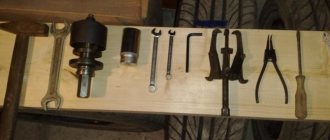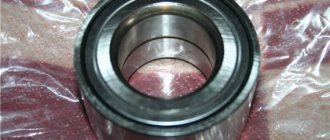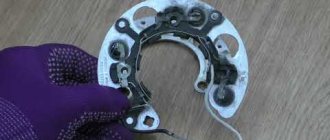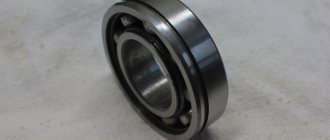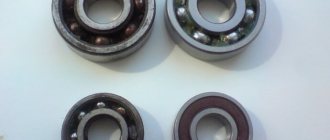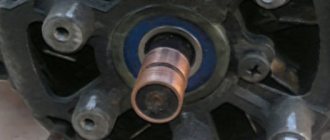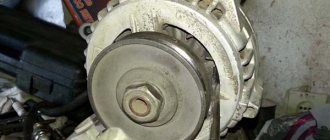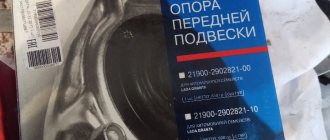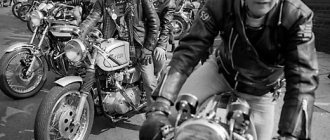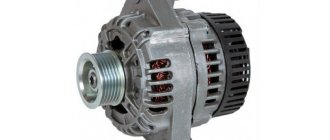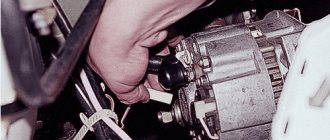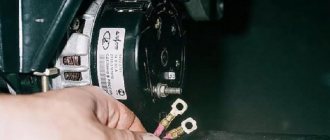Car owners have more than once encountered a situation where the chassis of their vehicle required replacing the wheel bearing. It’s good if the car enthusiast “played ahead of the curve,” but it’s much worse when a howling bearing ultimately becomes the cause of a serious accident with all the ensuing consequences. We will devote today's article to wheel bearings - their purpose, types, and the reasons why they fail over time.
What are wheel bearings needed for?
The main purpose of wheel bearings is to ensure uniform rotation of the wheels of the car. As you might guess from the name, they are the connecting link between the vehicle axle and the hub, to which the brake disc and the wheel itself are attached using studs and nuts.
By design, wheel bearings are classic rolling bearings. They consist of two metal rings, between which conical elements are pressed, separated from the body by a special insulator made of high-density rubber.
Pro tips, nuances when replacing a wheel bearing
The technology for replacing a wheel bearing is not complicated, but it requires special equipment - a press or a powerful bench vice. The method of hammering the unit using a hammer with an adapter is not suitable for working with hubs, as there is a high risk of misalignment of the unit or damage to the wheel bearing seat.
When installing a new bearing, pay attention to how easily it fits. The bearing should fit very tightly into the hub, and slight resistance indicates wear on the seat. In this case, the hub must be replaced. When seating a new bearing, pay attention to its centering, otherwise during installation there is a risk that it will become distorted and damage the surface of the seat. You can learn more about replacing the wheel bearing in this video.
What types of wheel bearings are there?
In the modern automotive industry, there is a significant difference between wheel bearings used in foreign cars and bearings intended for Russian models. Foreign parts have a much more complex design, ensuring the highest level of reliability. Foreign concerns mainly resort to the use of “HUB” wheel bearings of the 2nd and 3rd generations. These bearings have flanges for attachment to brake discs or to the wheel hub housing. Often the bearing is attached to both of these parts at the same time. In addition, the HUB-2 and HUB-3 bearings are equipped with a special electronic sensor. Such a device greatly simplifies the installation and alignment of bearings, allowing the degree of wear to be determined with high accuracy.
With domestic cars everything is noticeably worse. Front-wheel drive VAZ models still receive obsolete double-row sealed “HUB-1” bearings. On Nivas, engineers use single-row tapered wheel bearings. It's about the same story with other models, including commercial cargo vehicles. These bearings are quite difficult to install, have strict requirements for the accuracy of the tightening torque and require a constant supply of large amounts of lubricant. Unfortunately, apart from 1st generation “HUB” bearings and zero-class bearings, Russian manufacturers do not produce anything.
Main varieties
The rolling elements in wheel bearings are rollers and balls of cylindrical or conical shape. They can be lined up in 1 or 2 rows. The most commonly used types today are:
- cylindrical ball/roller;
- conical radial thrust roller.
Modern hub models produced for cars with anti-lock braking systems are an integral part of the hub. They have closed structures and are not maintained or repaired. If the unit breaks, the entire hub must be replaced.
Each radial model is fixed separately in the hub. All bearings, as mentioned above, are sealed and maintenance-free. They also cannot be adjusted. Backlashes that arise during vehicle operation are eliminated by placing the bearing on the axle using strong tension.
Some bearings (angular contact) are mounted on the hub two at a time. These are open models that are installed using low tension. If backlashes form, they can be adjusted.
The driving axle is usually equipped with radial hub parts, while the driven axle is equipped with radial contact parts. For example, the Russian VAZ car is equipped as follows:
- VAZ 2107 - the rear hubs are equipped with ball bearings (one each, and the front ones are conical (two);
- VAZ 2108 - conical units are installed on the rear axle, and cylindrical dual-core components are installed in front.
What is the service life of a wheel bearing, and what affects its wear?
Wheel bearings do not have a strictly regulated service life. Based on operating practice, if installed correctly, they can last more than 100 thousand kilometers. Agree, the resource is quite impressive. The average driver does not need to replace this part for several years.
Unfortunately, there are many factors that negatively affect the bearing. They significantly reduce the duration of its uninterrupted operation.
- Poor condition of roads . This is the main reason why most wheel bearings fail. The fact is that, being in the wheel, they take on the full force of the shock loads that inevitably arise during the trip. The force is sustained for some time, but after reaching a certain level of “fatigue,” the bearing begins to collapse.
- Aggressive operating environments . In summer, this impact is expressed in the form of road dust and moisture getting inside the hub; in winter, the situation becomes even more complicated due to chemical reagents abundantly poured onto the roads by utility workers.
- Overheating . Wheel rotation is always associated with operation at elevated temperatures. Constant alternation of heating with cooling, especially in winter, affects the life of bearings, significantly reducing it.
Adjustment work
To carry out adjustment work, you will need screwdrivers, a hammer, pliers and a standard set of keys. The adjustment on all cars is virtually identical and differs only in some details.
- On the hub that needs to be adjusted, loosen the wheel bolts.
- Using a jack, lift and remove the wheel.
- Using a hammer and screwdriver, knock off the protective cap mounted in the center of the hub.
- Using pliers, bend the stopper's antennae and pull it out.
- Tighten the hub nut until it stops, then unscrew it back ¼ turn.
- Check that the hub rotates easily. It should spin easily without jamming.
- Put everything back together and check the play again.
If adjustment fails to eliminate play or you notice crunching and jamming during rotation, the bearing must be replaced.
Symptoms of failure
This is where the most interesting thing is - how to determine a malfunction; there are several hundred percent methods.
1) “Dry” crunch . When a wheel bearing fails, a crunching sound appears when driving. These are spherical elements rolling. They broke the clip they were in and are now not evenly distributed. You won’t confuse this sound with anything else; believe me, this sound is perfectly audible in the cabin. This is the very first symptom - as soon as such a sound appears, we immediately go to the service station.
2) Vibration . If the bearing is already well worn, then vibration should appear in both the steering wheel and the body. This suggests that the spherical elements have already worn out the bearing race well, a little more and a “wedge” may occur. We change it urgently.
3) The car is pulled to the side . It is also possible that the part with the faulty element does not work normally - so to speak, it is stuck a little, and therefore the car will pull in one direction or another, as if the wheel alignment .
Signs of wear
At the initial stages, it is almost impossible to determine the malfunction without special equipment. This becomes clear only when there is noise from the wheel. This is precisely the first sign of bearing wear. The hum is very similar to the noise from an airplane. The same noise can occur when the hub nut is tightened too tightly or when it is loosely tightened. The noise is usually different at different speeds. Play in the wheel may also be a sign of a wheel bearing failure.
The easiest way to determine if there is a problem with the hub is to tap the tires with your feet. If there is a certain play or sound when tapping, then this may be the first sign long before the hum.
If the hub has already begun to hum, knock or crackle when driving, then you need to conduct a more detailed inspection of the unit and its subsequent repair. Driving on roads can be dangerous for you and others.
What is needed for replacement
Since the wheel bearing is a small part, to replace it the car must be driven into a well-lit room. The replacement can be carried out in an inspection hole or on a flat surface. Then you need to prepare tools and materials.
Wheel Bearing Replacement Tools
On a note! Replacing the rear hub bearings is an easier procedure when compared to the front elements, so experts recommend starting work from the front unit.
List of tools needed to successfully replace wheel bearings:
- wrench for 17 and 19;
- flat screwdriver;
- work gloves;
- a clean rag for wiping parts;
- head 30 with knob;
- mandrel for knocking out the hub;
- puller (a tool for removing a bearing).
Rear wheel bearing replacement tool
In addition to tools, you also need to buy bearings. When choosing parts, it is advisable to give preference to originals , at worst to a Russian manufacturer. It is better to abandon Chinese analogues - experiments are not appropriate here. Poor quality parts can damage the vehicle's chassis.
How to choose a wheel bearing
How to distinguish an original from a fake
Before buying bearings, you need to find out the characteristics of the original product. For example, special coded markings can be applied to rings, and a holographic label can be applied to cardboard packaging. Some manufacturers include mounting elements (for example, fastening nuts or seals) in the kit, allowing assembly of the unit without purchasing additional spare parts.
Information about the labeling or composition of the kit is available on the websites or in the official catalogs of manufacturers.
In mid-2022, the JTECT concern, which owns the Japanese manufacturer Koyo, together with the WBA (World Bearing Association, an international association of bearing manufacturers), introduced a program to verify the authenticity of products using a QR code printed on the packaging. After comparing the information with the database, a green or red indicator is displayed on the smartphone screen, indicating the original origin or counterfeit. As of mid-2022, the labeling program is in the development stage, and mass application of labels on packaging has not begun.
How the hub works
The hubs, both front and rear, are the same size, but the individual parts included in them differ in size. As for the caps, they all have the same dimensions, since they cover standard nuts. Each bearing has its own ring into which the axle must be inserted; oil is used during its assembly and installation.
The entire service life of the bearing can be done without additional lubrication. This means that there will be no need to disassemble this system of parts. This means that the cap on each nut will remain in place. But sometimes they still have to be replaced, since the cap can come off due to mechanical damage when driving on the highway.
When installing the bearing, it is necessary to slightly pull it onto the neck onto the inner ring, and then onto the outer ring, where even more effort is required. It is important to follow all safety rules during installation. If everything is done correctly, then there will be no problems during further removal, and the service life can be significantly increased. And the size of individual parts does not play a big role here.
The bearing must be tightened from the inside using a self-locking nut. Its dimensions are indicated on the head. The clamping should be up to twenty kilograms with force. Since it has a side that is crimped along its ellipse, when clamped it becomes tight, acting as a stopper.
In order for the bearing to be protected from dirt, there is another part that is formed due to the conical surface. We are talking about a hinge and a steering knuckle, which, with the centrifugal effect, are capable of reflecting all the dirt flying from the road. This is why caps are also put on the nuts, so that they also do not become littered.
The part in question can be installed on the rear wheels using the outer diameter. At the same time, it gets inside the hub, where it is locked by a ring. Here it is important to use high-quality nuts to tighten everything well, then the bearing will hold tightly.
